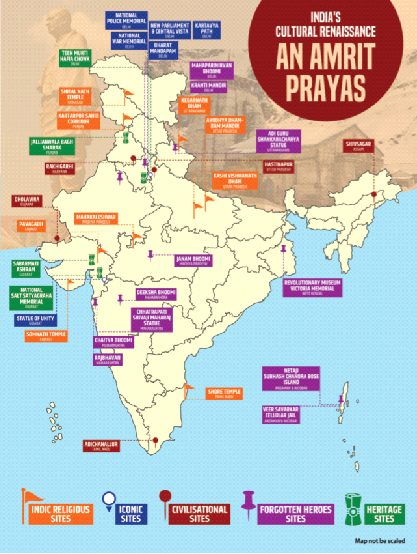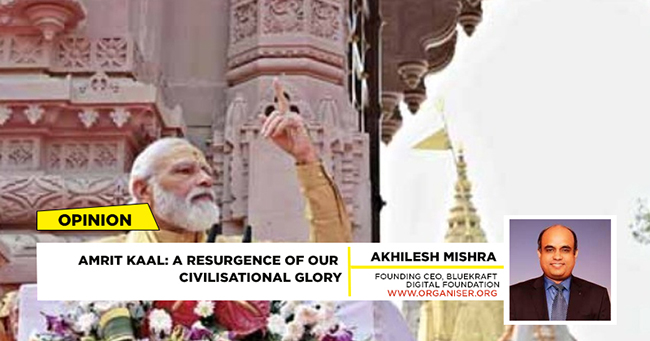Prime Minister Narendra Modi’s nine plus years in office will be remembered for many great historical contributions but perhaps the greatest will be how meticulously he has awakened the national pride in our very being as a nation, as a people and as a civilisation. In his 9th address to the nation from the ramparts of the Red Fort on August 15, 2022, he introduced us to the Panch Pran or the five resolves of Amrit Kaal. The awe inspiring and cohesive manifestation of these five resolves can be seen in the renewal of our heritage and the purposeful revival of the pillars of the oldest continuously living human civilisation.
Specifically, the cultural and civilizational revival has also been built around five pillars. These five pillars are resurgence of Indic religious and spiritual sites, including and specifically Hindu religious sites; creation of new national iconic sites; preservation and rejuvenation of our civilisational sites; honouring our true but unsung heroes and finally the preservation and reclaiming of our national heritage.
Resurgence of Hindu and Indic Religious Sites
The reversal of seven decades of colonial mindset that made any talk of taking pride in Hindu religion in particular, and Indic religions in general, a matter of national sin is one of the greatest contributions of nine years of PM Modi Government. Today we have a Prime Minister who has demonstrated that there is no dichotomy in asserting his personal belief in the timelessness of the Sanatan Dharam while abiding by the Constitutional mandate of Sabka Saath Sabka Vikas.
The foundational work done in Kedarnath Dham, Kashi Vishwanath Dham, Kartarpur Sahib, Pavagadh, Ujjain Mahakaal, the Shore temple in Chennai, Somnath Dham, and the Shital Nath Temple in Kashmir are just few examples of the transformed mind space and landscape from Kashmir to Kanyakumari.

But what took place on August 5, 2020, will forever be etched in the annals of our civilisation. The Mughals came and disappeared into the dustbin of history. The Portuguese came and went. The Dutch came and went. The French came and went. The invading Afghans and the Persians came and disappeared. The British came, lasted a while but were also sent back. The Nehruvian construct dominated the first six decades of Independent India before it collapsed due to its own sins.
The world order has been written and rewritten and is now being re-written again in the 495 years that have elapsed since 1528 CE. In almost half-a-millennium since then, nearly everything that man once believed would last for eternity has faded away in the sands of time. But what did not fade away was the faith of a civilisation in Maryada Purushottam. The times through these centuries were dark, the sacrifices asked and made were immense, the battle may have seemed to be insurmountable at times, and yet the faith persevered. August 5, 2020, was the vindication of that faith and belief. As the Grand Ram Mandir at the birth place of Bhagwan Ram opens for devotees in January 2024, PM Modi will go down in history as the Bhagirath Prayasi who not just organised the first leg of the momentous Ram Rath Yatra in 1990 but was later at the right place to lay its foundation in 2020 and inaugurate it in 2024.
Take the example of the temple of Pavagadh. Around 500 years ago, Mehmood Begada had attacked the temple and destroyed its shikhar (top). It is because of this reason that the Mandir dhwaja or flag could not be unfurled at the shikhar. Finally, after 75 years of Independence and five centuries subsequent to the destruction, PM Modi unfurled the flag atop the redeveloped temple site. Or consider Kashi Vishwanath. After Ahilyabai Holkar, it was Narendra Modi who is ensuring inch-by-inch that Mahadev’s dhaam returns to its original glory and any vestiges of invaders around the temple are put into dust.
BUILDING NEW ICONIC NATIONAL SITES
The Statue of Unity in Gujarat, honouring Sardar Patel, is one of the greatest examples of creating new iconic sites in tune with our national ethos. Sardar Patel’s contribution in uniting our civilisational nation into a modern state is unique in our history and the towering Statue is a befitting tribute to those billions who believe in the indestructability of Bharat.
But the Statue for the uniter of Bharat is not alone. The New Parliament with the traditional Sengol installed in it; the revamped Kartavya Path in Delhi; the National War Memorial, the National Police Memorial and the newly built Bharat Mandapam in Delhi are just some of the examples of creation of new icons as per our traditions and cultural practices.
REJUVENATION OF OUR CIVILISATIONAL SITES
Dholavira, one of the greatest living proofs of the achievements of Sindhu civilisation, but lying neglected for decades, has been given due recognition not just in terms of preservation but also in terms of spreading awareness around it. The area now has an elaborate irrigation system that has boosted farming, and propelled the handicraft and tourism industry benefitting Kutch’s economy. Today, Kutch is an international tourist spot and Dholavira is a UNESCO world heritage site.
Be it Shivsagar in Assam or Rakhigarahi in Haryana, Adichanallur in Tamil Nadu or Hastinapur in Haryana, the majesty of our unbroken, continuously living civilisation is being given its due place.
HONOURING THE UNSUNG HEROES
Constructing celebratory sites as homage, or preserving sites associated with the lives of our true but often unsung heroes has been an unprecedented commitment of PM Modi. A tall example of this is the revisitation of the Veer Savarkar Cellular Jail. Illustrious homage was paid only under this Government to our great patriots, the tallest among them being Veer Savarkar. The jail cell in which Savarkar was incarcerated by the British is now a pilgrimage site for all nationalists with Prime Minister himself bowing down in respect to this great son of Bharat Mata.
“The Andaman and Nicobar Islands are not just a symbol of India’s natural beauty, but they are also a place of pilgrimage for Indians as it reminds us of the collective resolve of our freedom fighters,” said the Prime Minister on December 30, 2018 when he laid a wreath at the Martyr’s column. Netaji Subhash Chandra Bose’s contribution to our freedom struggle was honoured only 75 years after Netaji himself hoisted the tricolour on Indian soil, fulfilling his promise that INA would stand on Indian soil by the end of 1943, and declaring the islands as independent Indian territories. Had the Modi government not taken cognisance of the significance of this valorous act, our future generations would never have known of it!
The installation of Netaji’s statue at the canopy of India Gate, where once stood the humiliating statue of the British King, has made it clear to every Indian that, in this New India, the icons will be Indians.
Today, the entire façade and structure of the iconic site (Jallianwala Bagh) Is upgraded while every inch of the site that reminds of the tragedy that took place in 1919 has been preserved
The museum dedicated to revolutionaries in Mumbai Rajbhavan or the bringing back of the ashes of Shyamji Krishna Verma; the revolutionaries museum in Victoria Memorial in Kolkata or the Kranti Mandir in New Delhi are all testament to the fact that the monopoly of one family on the Indian narrative is over.
The Panch Teerth dedicated to Babasaheb Ambedkar, built at five sites related to his life, are a reminder that our resurgence will be built and sustained by celebrating those who believed in our values and our culture. They will be our true heroes and the inspiration for future generations. Babasaheb’s life is a story of the ingenuity of human spirit, of triumph in adversity, and the Panch Teerth will educate our future generations that if Dr Ambedkar could do it then they can too.
PRESERVATION AND RECLAIMING OF NATIONAL HERITAGE
Our national heritage sites have undergone a massive transformation. Take the Jallianwallah Bagh; the living proof of a national tragedy that represents a defining moment in the history of defiance of the people of colonised India. Yet, tragically, Jallianwallah Bagh was the subject of gross neglect all these years. But today, the entire façade and structure of the iconic site is upgraded while every inch of the site that reminds of the tragedy that took place in 1919 has been preserved. It now houses four galleries portraying the moving history of the Jallianwala Bagh and depicting the rich history of Punjab. Similarly, the Teen Moorti Haifa Chowk has been redeveloped and dedicated to the three Indian cavalry regiments of the Indian Army who fought the winning battle of Haifa in 1918 – a symbol of the camaraderie between India and Israel.
The upkeep and preservation of Sabarmati Ashram in Gujarat and the construction of the National Salt Satyagrah Memorial by PM Modi in 2019 are dedicated towards preserving and propagating the legacy of Mahatma Gandhi in its true spirit. But what truly outshines PM Modi is his painstaking effort in bringing back stolen artifacts. Over 400 such artifacts have come back from across the world and are finding their rightful place in Temples and Indian Museums.



















Comments